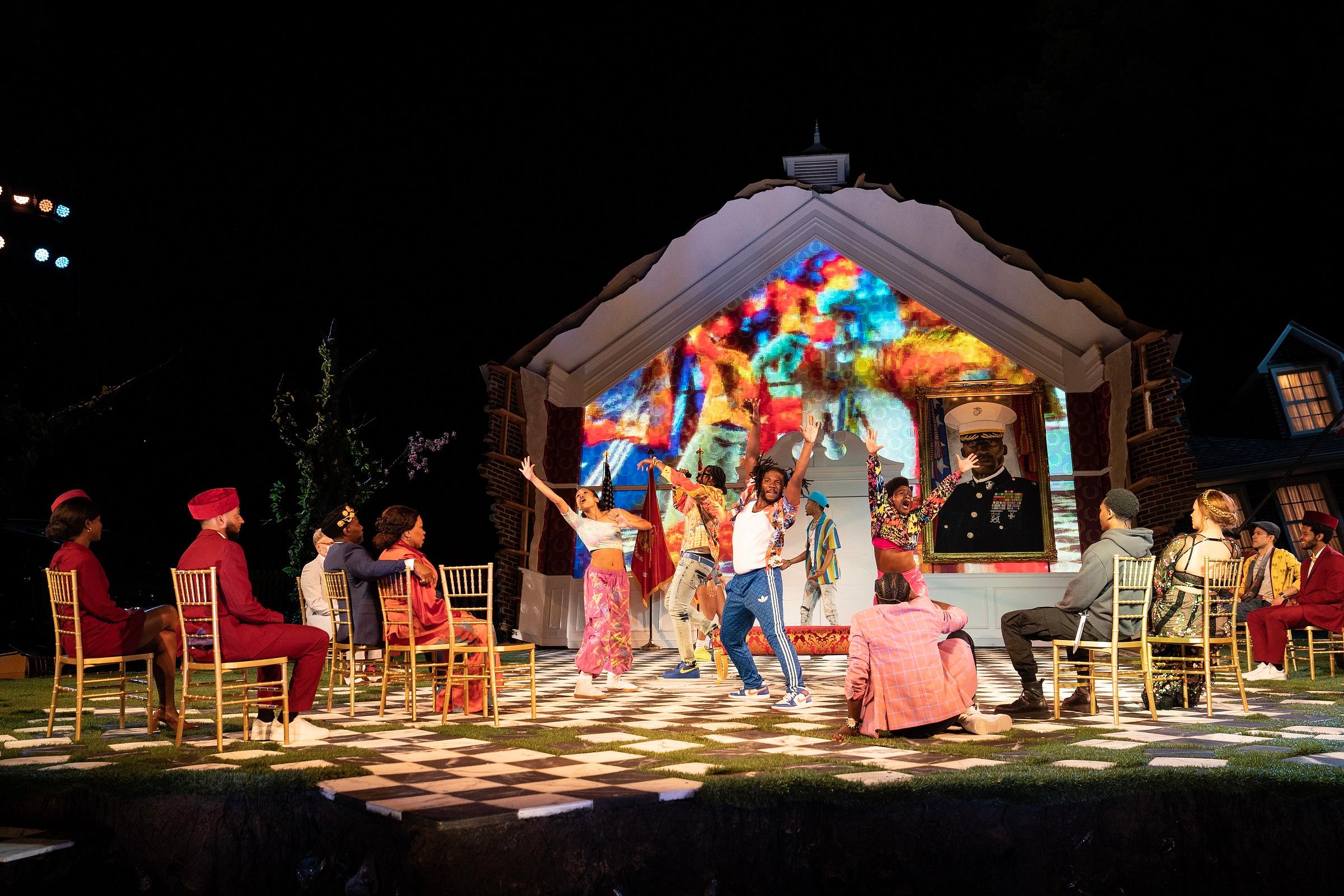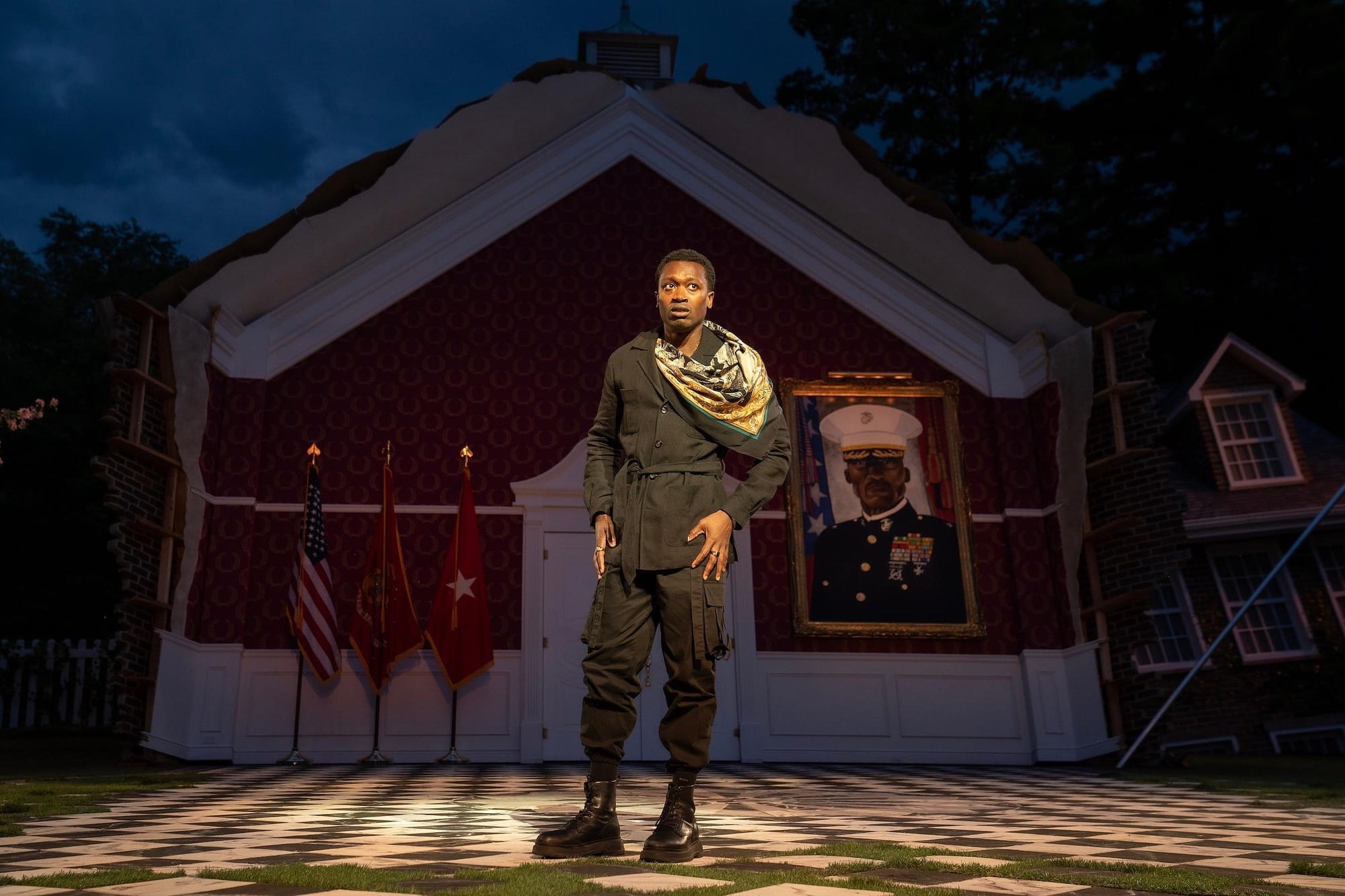Manhattan — Confession: I had never read or seen Hamlet before I attended the Public Theater’s Free Shakespeare In the Park production of the play, helmed by Tony Award-winning director Kenny Leon.
Leon’s contemporary interpretation of the work, centering the tale of betrayal and revenge on a Black Georgia family, generates thrilling moments — and a few missed opportunities.
In the original play, Hamlet (played here by Ato Blankson-Wood) hatches a winding and deadly plot to avenge the death of his father, who was murdered by Hamlet’s uncle, Claudius (John Douglas Thompson), who then married Hamlet’s mother, Gertrude (Lorraine Toussaint), to become king.
Leon’s Hamlet — running through Aug. 6 the Delacorte Theater in Central Park — makes the play sing, both figuratively and literally.
Between the gospel a cappella performance in the play’s opening funeral scene, the hip-hop remix of The Mousetrap play within the play, and the fluid rhythm of each scene in between, the production I saw highlighted how Shakespeare’s words are music as much as they are prose.
Leon’s tuneful vision wasbolstered by additional original compositions from Jason Michael Webb. Leon sprinkled in some alterations that modernize and build additional suspense within Shakespeare’s original drama. Having Claudius directly pay Rosencrantz (Mitchell Winter) and Guildenstern (Brandon Gill) to kill young Hamlet, their childhood friend, as opposed to engaging them only for indirect treachery as originally written, was one brilliant example. The change led to gasps from around the audience, and paved the way for riveting performances from all involved as that conflict played out.
Blankson-Wood gave an enthralling performance as Hamlet, frictionlessly toggling between angst, cunning, and vulnerability in his interactions with friends, foes, and everyone in between, and baring his soul in the play’s famous soliloquies.
There were multiple standout performances. Daniel Pierce overflowed with goofy, loveable uncle energy as Polonius, advisor to Claudius and father of Ophelia, making his ultimate demise all the more painful to witness. John Douglas Thompson won me over in the second half as Claudius, as his diplomatic facade slipped away and he made it clear that he would stop at nothing to eliminate any threat to his throne. Safiya Harris, the understudy on for Ophelia, Hamlet’s estranged lover, displayed supreme prowess as both a vocalist and actress. She didn’t miss a beat in her delightfully disturbing rendition of Ophelia’s melodic downward spiral.
Last, but certainly not least, was our Hamlet. In his note in the Playbill, The Public Theater’s artistic director, Oskar Eustis, asserts that “Hamlet’s madness remains… a mystery” for which “there’s no such explanation.” If Eustis is to be believed, then Ato Blankson-Wood has accomplished the impossible. Blankson-Wood gave an especially enthralling performance as Hamlet, leaving very little room for confusion on my part as he frictionlessly toggled between angst, cunning, and vulnerability in his interactions with friends, foes, and everyone in between. It was a treat to experience him bearing his soul in the famous celebrated “Hamlet” soliloquies.
Those soliloquies were beautifully lit by Allen Lee Hughes, whose design allowed the play to smoothly transition between the chaos and heartbreak of Hamlet’s daytime scenes and the reflective, lonely, and still quality of his moonlit monologues. Beowulf Boritt’s scenic design places the details that mark the play’s contemporary Georgia setting (including a “Stacey Abrams 2020” banner half-buried in the ground) around the periphery of the set. This allows the automated trap floor in the center of the stage to make switches between scenes and locations breezy and seamless. These elements combined with Justin Ellington’s spine-chilling sound design and Jeff Sugg’s realilty-warping projection design to create a haunting portrayal of the ghost of Hamlet’s father, an apparition whose presence drastically changes the visual and sonic language of the play. It gave me goosebumps.
There were two moments, however, when I felt Leon’s contemporary staging hindered the storytelling rather than helping it.
The opening scene appeared to be a Covid-conscious funeral for Hamlet’s father, with characters entering and exiting the stage to pay their respects one by one. Given the disregard for social distancing in the rest of the play and the importance of the characters’ established relationships, I question whether sacrificing this early opportunity to see characters interact and respond to each other, even if silently and in the background, was worth it.
Later, in an attempt to capture Claudius’ guilty conscience, Hamlet called for a staging of The Mousetrap, a play whose action closely mimics the duplicitous circumstances of his father’s murder. Leon’s delightful reimagining of the play within the play, the action of the players (Colby Lewis, Mikhail Calliste, Lauryn Haynes, Lawanda Hopkins) happened center stage, with the other characters seated around them in a circle. Claudius was seated downstage, with his back to the left side of the audience, partially obstructing my view of “The Mousetrap” and Camille A. Brown’s stellar choreography. This wasn’t ideal, given that Claudius’ reaction to the play is supposed to prove his guilt in murdering Hamlet’s father. Leon’s solution to this is to have Hamlet’s main friend and ally, Horatio (Warner Miller), film “The Mousetrap” and Claudius on his phone, with a recording simultaneously being projected onto the back wall of the set. The projected video was grainy and had a low frame rate, however, making me wish I just had an unobstructed view.
Despite spending nearly three hours in the intricate world of Hamlet, I rarely felt that the performance dragged, nor did I ever feel lost in the plot or language of the play. As someone completely new to the work, I consider this a triumph. I primarily credit this to the strength and clarity of Leon’s direction, but also partially to the open captions available at the performance I attended. The captions, presented by the Theatrical Development Fund (TDF) on digital screens to the left and right of the stage, ensured I caught every word of the play.
Perhaps the most impactful part of my first Hamlet experience was the ending, as it surely was one that neither Leon nor Shakespeare had intended. Partway through Act IV, just as Ophelia’s emotional disintegration was reaching a fever pitch, the performance was held and subsequently suspended due to weather concerns. The call wasn’t a complete surprise, as thunderstorms had been threatening the area all day long, and there was an extended intermission to allow for lightning to pass. It was almost 11 p.m., I had been sitting out in the summer heat for over 3 hours, and a storm was approaching. And yet, I was devastated and reluctant to be ushered out of the theater. I was and still am desperate to see how Hamlet’s story ends.
Confession: Due to the circumstances above, I technically still haven’t seen or read Hamlet in its entirety yet. But, to Leon and the Hamlet team’s credit, I’m determined to change that. I will certainly be back to the park for another go at the show, rain or shine.
Still playing: Hamlet runs through Aug. 6 at the Delacorte Theater in Central Park. The Public Theater offers free tickets to every performance through a variety of distribution methods digitally and in-person around New York City; access information about those distributions here.
Where I’m going next: The Half-God of Rainfall at New York Theater Workshop.







